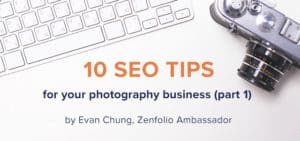10 Tips To Improve SEO For Your Business: Part 2
October 31st, 2018
As a continuation from last week’s 10 Tips To Improve SEO For Your Business: Part 1, we’re sharing the rest of Evan Chung’s Top 10 SEO Tips for your photography business. Evan Chung is a Zenfolio Ambassador, Bay Area wedding photographer, and all around SEO wizard. He gave us some great tips, so great that we actually had to split it into two separate post. So without further ado, here’s part 2 of Evan’s Top 10 SEO Tips.
Tip #6: Headers, Captions, And Descriptions, Oh My!
Headers, captions and main body descriptions are all under Google’s scrutiny. Your title and header copy are the first things investigated by Google. So make sure the copy that you assign title or heading formatting to are rich with SEO content. Then, when writing your description, captions, or body content, be sure to have correct spelling, punctuation, sentence structure and no invisible formatting (This is when you have the same text color as background color. Google is too smart now and will ding you for it). You might wonder why this has become so important and the answer is readability for the searcher. Google rates website by relevance to the person searching and the search term(s). So a badly written webpage with a high bounce rate and short visitor duration does not look as relevant as a page that keeps the reader’s attention. This is how we should think about SEO now. If something ultimately helps the searcher, then Google likes it.
Tips #7: Naming Your Photo Files And Links
When deciding on your file naming convention, think about what you want to be discovered for in a google search. A bad filename example would be IMG1234.jpg or even JohnSarah_engagement_1234.jpg. The first example has zero SEO value while the second has very little since the only thing that might be helpful to Google is the word, “engagement”. A much better filename would be something like this: San-Francisco-Pier-39-Engagement-photos-1234.jpg. There are two reasons that improves your SEO; (1) instead of underscore, the filename uses a dash which Google interprets as a space and (2) if you read the filename as a phrase with “-” as a space, then it provide rich SEO content and is much more likely to be served up in a search result because of it. The same method applies to creating friendly links for your custom website pages and blog posts.
Tip #8: Blog Frequently
An actively updated blog is the best thing you can do to drive traffic to your site. Consider hosting your blog on the same site as your main website so that your visitor count isn’t split between the two websites. As for the blog content itself, the better the content quality, the more likely people will want to read it. Ideally, an actively visited site would have one to two blog posts per week with at least 300-500 words per post. If you can carve out the time to create a long form post with 1000+ words, even better! This is where your descriptions and search-friendly phrases can really shine. However, this is a daunting task, so work up to it slowly and try to keep a regularly posting routine for Google to rely on for indexing.
Tip #9: Likes Without Links
Social media is a great place to create organic buzz and activity for your business. Just remember to link back to your website. This drives traffic to your website and encourages visitors to browse your site rather than browse social media. The more traffic that comes to your site, the higher Google is likely to rank you. The flip side of that coin is that if you’re staying active on social media but not driving traffic to your website using links, then there is no SEO benefit from all the social media activity. Social media may still be a pertinent business strategy, but Google will not give you website credit for facebook popularity.
Tip #10: Drive Referring Sites
Get the word out! Any credible site that is linking back to your site is good for your SEO. Some great strategies for generating referring sites are enter photos contests, win awards, industry publications, popular vendor directory listings, collaborative partner sites, volunteer your service to charity, etc. These are great ways to generate positive, authoritative links pointing back to your website. However make sure that these referring sites have good site rankings because the reputation of the referring site will be conferred onto your own reputation. You don’t want a bad website’s reputation to bring your own reputation down.
Those are my top 10 tips for SEO, and remember that Rome wasn’t built in a day. The same goes for your website’s SEO. The best website SEO takes time to create, so slow down, make a plan and baby step your way into SEO greatness.
ABOUT THE AUTHOR
Evan Chung is a San Francisco Bay Area wedding photographer and an expert on website SEO/branding and small business marketing. He is also a former Zenfolio Zenmaster and now a part of the Zenfolio Ambassador Team. His beautiful and engaging imagery showcases his love for people and capturing emotions on camera while his photography seminars and workshops display his passion for website excellence. It is easy to see his dedication to his craft and his desire to reinvest back into the photography community.
Check out his work at www.evanchungphoto.com and follow him on Instagram and Facebook.


